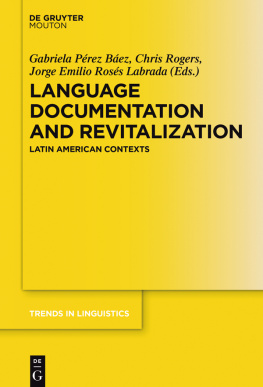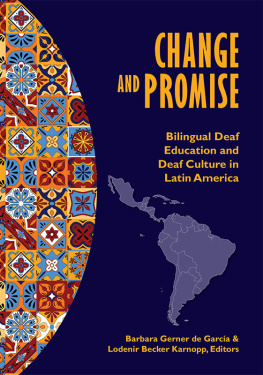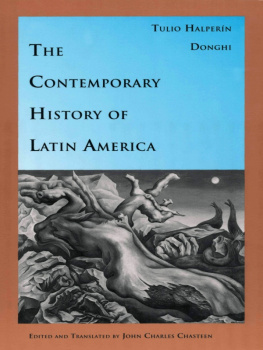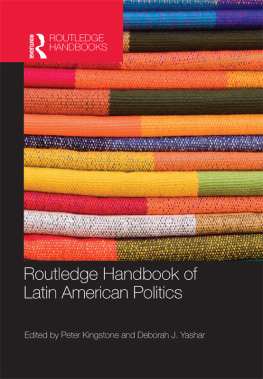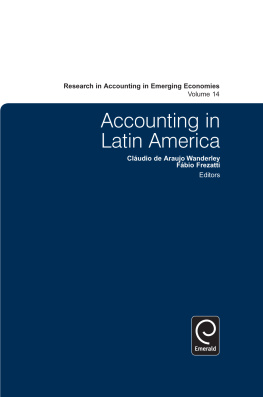Language Documentation and Revitalization in Latin American Contexts
Guide

Gabriela Prez Bez, Chris Rogers, Jorge Emilio Ross Labrada (Eds.)
Language Documentation and Revitalization in Latin American Contexts
Trends in Linguistics Studies and Monographs

Editor
Volker Gast
Editorial Board
Walter Bisang
Jan Terje Faarlund
Hans Henrich Hock
Natalia Levshina
Heiko Narrog
Matthias Schlesewsky
Amir Zeldes
Niina Ning Zhang
Editor responsible for this volume
Volker Gast
Volume 295

ISBN 978-3-11-043807-9
e-ISBN (PDF) 978-3-11-042890-2
e-ISBN (EPUB) 978-3-11-042894-0
ISSN 1861-4302
Library of Congress Cataloging-in-Publication Data
A CIP catalog record for this book has been applied for at the Library of Congress.
Bibliographic information published by the Deutsche Nationalbibliothek
The Deutsche Nationalbibliothek lists this publication in the Deutsche Nationalbibliografie; detailed bibliographic data are available on the Internet at http://dnb.dnb.de.
2016 Walter de Gruyter GmbH, Berlin/Boston
Typesetting: fidus Publikations-Service GmbH, Nrdlingen
www.degruyter.com
Gabriela Prez Bez, Chris Rogers and Jorge Emilio Ross Labrada
1Introduction
Gabriela Prez Bez , Smithsonian Institution Chris Rogers , Brigham Young University Jorge Emilio Ross Labrada , University of British Columbia
1Overview
There has been a significant increase in the concern for and awareness about endangered languages within the field of linguistics. The responses to this social and linguistic issue fall into one of three categories: (1) language documentation in order to preserve these languages for scientific study and linguistic analysis; (2) language revitalization in order to expand the domains of use of a language through language planning programs, projects, and activities; and (3) the investigation of the causes and consequences of endangerment and the typological classification of endangered languages. An overarching theme common to these responses has been the development and use of ethical and methodological best practices for collaborating with language communities. All of these responses are significant and meaningful to language communities and scholars. However, the discussion and outcomes, including recommendations for best practices, are focused on widely-known language communities and sociolinguistic contexts in North America, Australia, Europe, or New Zealand (see Austin and Sallabank 2011; Brenzinger 2007; Crippen and Robinson 2013; Crystal 2000; Errington 2003; Fishman 1991; Gippert, Himmelmann, and Mosel 2006; Grenoble and Furbee 2010; Grenoble and Whaley 1998, 2006; Harrison, Rood, and Dwyer 2008; Hinton and Hale 2001; Krauss 1992; Moseley 2010; Nettle and Romaine 2000; Penfield et al. 2008; Rice 2006, 2012; and Whaley 2011; inter alia ). Literature that focuses on Latin American issues is scant. In particular, before the publication of this volume, there have been no book-length works examining through case studies the practicalities and methodologies of language documentation and language maintenance/revitalization with an exclusive focus on Latin American contexts. Other case-study book-length volumes on language documentation and language maintenance/ revitalization examine the topics dealt with in this volume but the number of chapters that focus on projects carried out in Latin America is limited or non-existent. For instance, only two out of 21 contributions in Grenoble and Furbee (2010) are devoted to Latin American languages. In comparison, there are five contributions on US Native American languages, and the bulk of the contributions is from researchers whose research is based in the US, Canada or Australia. There are no Latin American case studies in early publications such as Hinton and Hale (2001) nor are there any in more recent publications such as Haig et al. (2011). Thus, there is a need to make broadly available a wider set of case studies on language documentation and revitalization experiences in other parts of the world as do, for example, Franchetto and Rice (2014), Cruz and Woodbury (2014) and Stenzel (2014), among others. It is to this end that the 11 case studies presented in this volume describe, compare, and contrast language documentation and/or revitalization experiences throughout Latin America in light of the previously published information.
Language documentation and revitalization in communities in Latin America is characterized by a number of unique factors (see below) that must be considered in order for the responses to language endangerment in the region to be appropriate, meaningful, or effective. These characteristics are the result of a high level of linguistic diversity, varying levels of social and political development, and a diverse set of cultural practices. For example, Latin America is home to over 100 distinct language families whose languages are spoken in communities of all sizes (ranging from millions of speakers on the one hand to a single speaker on the other). Some of these languages are official languages in the countries where they are spoken (e.g., Guaran, Quechua, Aymara) while most others are scarcely recognized by their national governments. In conjunction with this, many language communities, despite desiring to document and revitalize their languages, do not have the social, political, or economic infrastructure in place to support language planning projects. In other cases, communities may not perceive their languages as endangered because social and cultural practices mask the signs of ongoing language shift. When considered altogether, this means that expectations and best practices for language documentation and revitalization in Latin America are different from the ones outlined in sources such as those cited above. It is consequently clear that addressing these differences can help in developing better responses to the global concern for language endangerment.
In order to show how these differences affect the practice of language documentation and revitalization, each chapter in this volume presents a case study highlighting one or more of the factors representative of the situation. These case studies were originally presented and discussed in a special panel at the 2013 Annual Meeting of the Society for the Study of the Languages of the Americas in conjunction with the Linguistic Society of America . This special panel highlighted a number of issues and challenges for community members, scholars, and researchers working with communities in Latin America, which present a unique context for responding to language endangerment. These can be summarized into the following list of factors:
High levels of linguistic and dialectal diversity
Lack of social, political, and/ or economic resources
Lack of infrastructure to support language planning projects, programs, and activities
Community perception of documentation and/ or revitalization projects and engagement in them
Community expectations as to the outcomes for language documentation and revitalization
Response to and acceptance of ethical behavior prescribed by the field of linguistics
Geographic distance and terrain, and geopolitical borders
Each of these factors was present in two or more situations discussed in the special panel and are thus discussed here in the different chapters. However, we certainly do not claim that this list is exhaustive, as we expect further research and discussions to refine this list both for Latin America and elsewhere. This is especially true because we acknowledge that this list represents macro-factors that, upon close examination, encompass a number of smaller issues that need to be evaluated and understood in light of a broader discussion on language endangerment, documentation, and revitalization. For example, infrastructure encompasses local and national support as well as a correlation to individual motivation. Nevertheless, as a whole, the set of case studies presented here support our claim that the response to language endangerment in communities throughout Latin America is different from that suggested or expected in more widely known discussions and publications. It is hoped that the broad geographic, linguistic and cultural representation of the cases discussed in this volume make it as relevant as possible to a broad audience of those interested in language documentation and revitalization in Latin American contexts and to those interested in improving language documentation and revitalization approaches at a global level.

